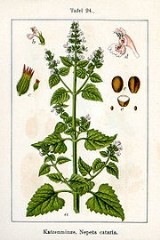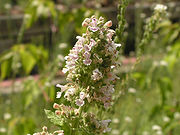
Nepeta cataria
Encyclopedia

Lamiaceae
The mints, taxonomically known as Lamiaceae or Labiatae, are a family of flowering plants. They have traditionally been considered closely related to Verbenaceae, but in the 1990s, phylogenetic studies suggested that many genera classified in Verbenaceae belong instead in Lamiaceae...
family. The common names can also be used to refer to the Nepeta
Nepeta
Nepeta is a genus of about 250 species of flowering plants in the family Lamiaceae. The members of this group are known as catnip or catmint because of their effect on cats—the nepetalactone contained in nepeta binds to the olfactory receptors of cats, typically resulting in temporary euphoria...
genus as a whole.
Cultivation
Variants include N. cataria var. citriodora (also called subsp. citriodora), lemon catnip.Toxicology
The plant terpenoid nepetalactoneNepetalactone
Nepetalactone is an organic compound, first isolated from the plant catnip , which acts as a cat attractant. Nepetalactone is bicyclic terpenoid, i.e., it is a ten-carbon compound derived from isoprene with two fused rings, a cyclopentane and a lactone. The structure and the effects of the compound...
is the main chemical constituent of the essential oil of Nepeta cataria. Nepetalactone can be extracted from catnip by steam distillation
Steam distillation
Steam distillation is a special type of distillation for temperature sensitive materials like natural aromatic compounds....
.
Humans
Catnip has a history of human medicinal use for its soothing properties. It has also been known to have a slightly numbing effect. The plant has been consumed as a tea, juice, tinctureTincture
A tincture is an alcoholic extract or solution of a non-volatile substance . To qualify as a tincture, the alcoholic extract is to have an ethanol percentage of at least 40-60%...
, infusion or poultice, and has also been smoked.
Cats
Nepeta cataria (and catmintsNepeta
Nepeta is a genus of about 250 species of flowering plants in the family Lamiaceae. The members of this group are known as catnip or catmint because of their effect on cats—the nepetalactone contained in nepeta binds to the olfactory receptors of cats, typically resulting in temporary euphoria...
) are mostly known for the behavioral effects they have on cat
Felidae
Felidae is the biological family of the cats; a member of this family is called a felid. Felids are the strictest carnivores of the thirteen terrestrial families in the order Carnivora, although the three families of marine mammals comprising the superfamily pinnipedia are as carnivorous as the...
s, not only domestic cats but also big cat
Big cat
The term big cat – which is not a biological classification – is used informally to distinguish the larger felid species from smaller ones. One definition of "big cat" includes the four members of the genus Panthera: the tiger, lion, jaguar, and leopard. Members of this genus are the only cats able...
s.
N. cataria is used as a recreational substance for pet cats' enjoyment, and catnip and laced-catnip products designed for use with domesticated cats are available to consumers. Not all cats are affected by catnip.
The common behaviors when cats sense the bruised leaves or stems of catnip are rubbing on the plant, rolling on the ground, pawing at it, licking it, chewing it consuming much of the plant followed by drooling, sleepiness, anxiety, leaping about and purring. Some will growl, meow
Meow
Meow is an imitative word for a sound made in cat communication. It may also refer to:- Music :* Miou Miou, a Czech pop band* Miaow , an English band* Miaow , a 1994 album by The Beautiful South...
, scratch, or bite the hand holding it. Some cats will eat dried catnip. Often, eating too much can cause cats to be overtly aggressive, typically making them hiss.
Pharmacology
Nepetalactone acts as a feline attractant. Roughly half to two thirds of cats will be affected by the plant.This chemical enters the feline's nose.
Cats detect it through their olfactory epithelium
Olfactory epithelium
The olfactory epithelium is a specialized epithelial tissue inside the nasal cavity that is involved in smell. In humans, it measures about 1 square centimetre and lies on the roof of the nasal cavity about 7 cm above and behind the nostrils...
, not through their vomeronasal organ
Vomeronasal organ
The vomeronasal organ , or Jacobson's organ, is an auxiliary olfactory sense organ that is found in many animals. It was discovered by Frederik Ruysch and later by Ludwig Jacobson in 1813....
.
At the olfactory epithelium
Olfactory epithelium
The olfactory epithelium is a specialized epithelial tissue inside the nasal cavity that is involved in smell. In humans, it measures about 1 square centimetre and lies on the roof of the nasal cavity about 7 cm above and behind the nostrils...
, the nepetalactone binds to one or more olfactory receptors. Some have speculated that it may mimic a cat pheromone
Cat pheromone
Cat pheromones are pheromones that are used by cats and other felids for cat communication.- Feline facial pheromone :Feline facial pheromone is a hypothetical pheromone used by cats to mark places, objects, and persons as familiar by rubbing their face on surfaces...
, such as the hypothetical feline facial pheromone
Cat pheromone
Cat pheromones are pheromones that are used by cats and other felids for cat communication.- Feline facial pheromone :Feline facial pheromone is a hypothetical pheromone used by cats to mark places, objects, and persons as familiar by rubbing their face on surfaces...
or the cat urine odorant MMB
3-Mercapto-3-methylbutan-1-ol
3-Mercapto-3-methylbutan-1-ol, abbreviated as MMB, is a thiol and an alcohol. MMB is a degradation product of felinine in cat urine and is a putative cat pheromone....
. However, this has not been tested.
Approximately two hours after an exposure, the feline will be sensitive to another dose. The phenomenon is hereditary; for example, most Australian cats do not react to it. There is some disagreement about the susceptibility of lion
Lion
The lion is one of the four big cats in the genus Panthera, and a member of the family Felidae. With some males exceeding 250 kg in weight, it is the second-largest living cat after the tiger...
s and tiger
Tiger
The tiger is the largest cat species, reaching a total body length of up to and weighing up to . Their most recognizable feature is a pattern of dark vertical stripes on reddish-orange fur with lighter underparts...
s to catnip.
Other plants that also have this effect on cats include valerian
Valerian (herb)
Valerian is a hardy perennial flowering plant, with heads of sweetly scented pink or white flowers which bloom in the summer months. Valerian flower extracts were used as a perfume in the sixteenth century....
(Valeriana officinalis) and plants that contain actinidine or dihydroactinidiolide
Dihydroactinidiolide
Dihydroactinidiolide is a volatile terpene. It has a sweet, tea-like odor and is used as a fragrance. Dihydroactinidiolide occurs naturally in black tea, fenugreek, fire ants, mangos, silver vine , and tobacco...
(Smith, 2005).
Other
Nepetalactone is a mosquito and fly repellent.Oil isolated from catnip by steam distillation is a repellent against insects, in particular mosquitoes, cockroaches and termites.
Research suggests that in a test tube, distilled nepetalactone
Nepetalactone
Nepetalactone is an organic compound, first isolated from the plant catnip , which acts as a cat attractant. Nepetalactone is bicyclic terpenoid, i.e., it is a ten-carbon compound derived from isoprene with two fused rings, a cyclopentane and a lactone. The structure and the effects of the compound...
, the active ingredient in catnip, repels mosquitoes ten times more effectively than DEET
DEET
N,N-Diethyl-meta-toluamide, abbreviated DEET, is a slightly yellow oil. It is the most common active ingredient in insect repellents...
, the active ingredient in most insect repellents,
but that it is not as effective a repellent when used on the skin.

